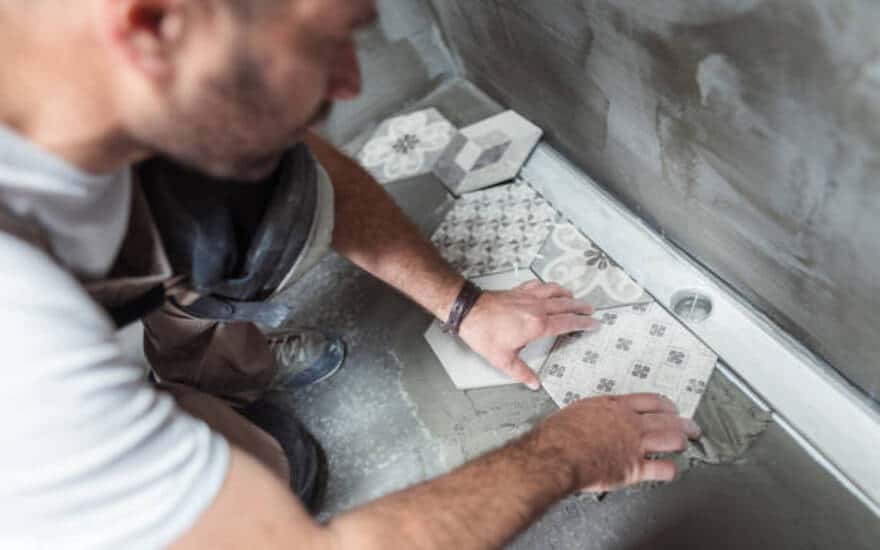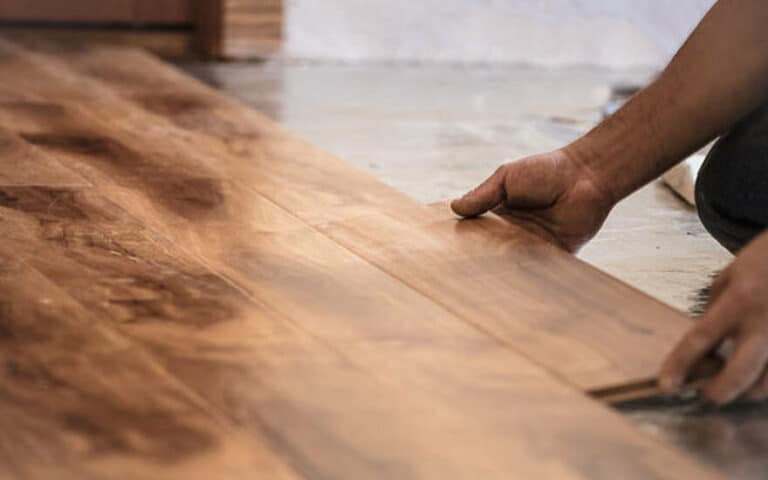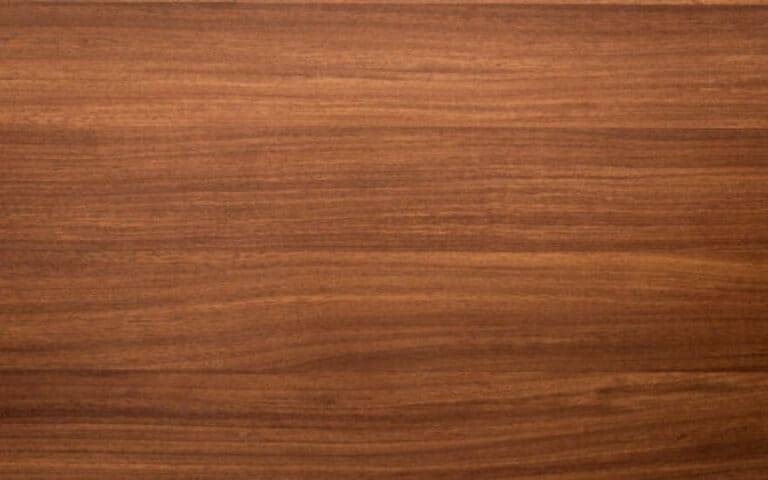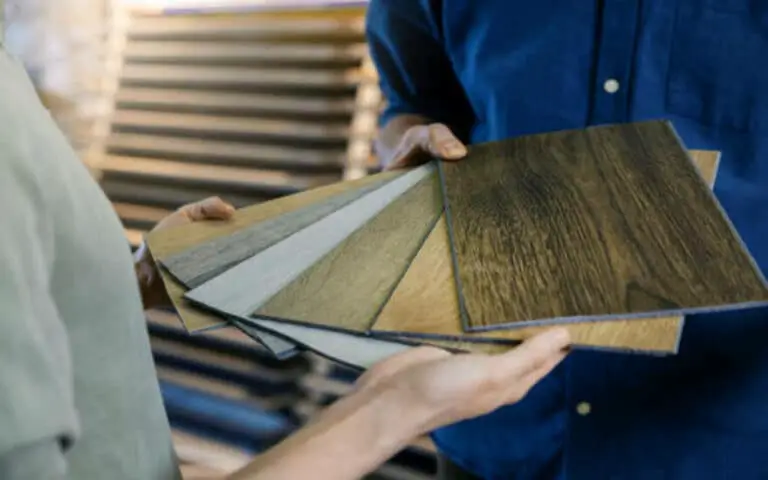If so, ceramic tile is a great option for updating the space. But before you start shopping for tiles, it’s important to understand the special considerations involved with ceramic tile bathroom flooring. This blog post will cover the key points you need to know before starting your project!

How to improve the slip-resistance of ceramic tile bathroom flooring?
Regarding ceramic tile bathroom flooring, slip resistance is an important factor. Thankfully, there are several ways to improve the slip-resistance of ceramic tile bathroom flooring without compromising on the look and feel of the space.
Anti-slip floor treatments using mild acid solutions, traction enhancement with products like Slip Grip or Grip On Anti-Slip Solution, and sealers that increase the slip resistance are available to improve slip resistance.
Natural stone tiles and textured surfaces can also be used to reduce slipping. With the right type of ceramic tile, grit additives, and anti-slip mats and stickers, you can create a luxurious spa-like bathroom floor that is also slip-resistant.
1. Slip-Resistant Coatings
When it comes to slip resistance, coatings are an important factor. Applying a mild acid solution to ceramics can help promote a slip-resistant surface.
There are also other anti-slip solutions like Halkstop, which can be applied directly to tiles to prevent slipping and falling. Specialized coatings and additives can also improve the slip resistance of existing floor tile.
Additionally, the thickness of the protective coating should be taken into account, as the thicker it is, the less slippery the surface will be. It is recommended that a safe floor should have a minimum reading of 40, wet or dry.
Furthermore, surface roughness, Rz, should also be considered when selecting a tile with a suitable CoF (Coefficient of Friction) value above 0.36, which is likely to have a low slip potential.
2. Textured Surfaces
In addition to slip-resistant coatings, you can improve the slip-resistance of ceramic tile bathroom flooring by using textured surfaces.
This includes tiles with a textured surface, anti-slip mats, and stickers. Textured surfaces are especially useful in wet areas, as they provide additional traction and help to reduce the risk of slips and falls.
Textured surfaces can also be used with slip-resistant coatings for maximum protection. When selecting textured surfaces, it’s important to pay attention to the type of material used and the size, color, and texture of the tile.
Additionally, you should consider the type of glaze used on the tile, as some glazes can reduce slip resistance. Finally, when laying a ceramic tile bathroom floor on top of an existing floor, be sure to account for cuts and corners when installing the tiles.
3. Anti-Slip Mats and Stickers
When it comes to anti-slip mats and stickers, these are great options for adding a bit of extra safety to a ceramic tile bathroom floor.
Mats and stickers can provide extra grip in areas prone to slipping, such as shower floors and wet areas. They can also create a decorative element in the bathroom, as they come in various colors and designs.
Most mats and stickers are made from rubber, making them easy to clean and maintain. They’re also relatively inexpensive and can be easily installed. So if you’re looking for an affordable way to make your ceramic tile bathroom flooring safer, anti-slip mats and stickers may be the perfect solution.
4. Grit Additives
Grit additives are another option to improve the slip resistance of ceramic tile bathroom flooring.
These can be added to the sealant or applied directly to the surface of the tiles. Small pieces of material such as sand, quartz, or other materials create a textured surface, increasing the coefficient of friction between the tile and the surface it is on.
This helps to provide better traction and a safer surface to walk on. Grit additives are often used in areas that experience high amounts of moisture and where people will be walking barefoot.
How to select the right type of ceramic tile for a high-moisture bathroom?
When selecting the right type of ceramic tile for your bathroom, there are a few things to consider. The grade of the tile is important, as it determines how well it will stand up to high-moisture environments.
For example, Grade 1 tiles are made of the highest quality materials and are best suited for bathrooms. Also, consider the tile’s size, color, and texture to ensure it will match the rest of your bathroom decor.
1. Understand Grades of Ceramic Tile
When selecting a ceramic tile for your bathroom, it’s important to understand the different grades of ceramic tile available on the market. Grade 1 ceramic tile is the most durable and can stand up to high-traffic areas.
It is also more resistant to scratches and other surface damage. On the other hand, porcelain tile is fired at a higher temperature and is often more expensive but also more water-resistant and harder than standard ceramic tile.
Furthermore, there are several other factors to consider when selecting the right type of ceramic tile for a bathroom floor, such as size, color, texture, and glaze.
2. Consider the Size, Color, and Texture of the Tile
When selecting the size, color, and texture of your ceramic tile, it is important to consider the size and shape of your bathroom.
If you have a smaller bathroom, consider using smaller tiles to help give the illusion of more space. Larger bathrooms can handle larger tiles. Additionally, consider choosing ceramic tiles with a high-gloss finish to give your bathroom an extra sparkle and shine.
Consider the color palette of your bathroom as well – light colors tend to open up a space, while darker shades can give a room a cozier feel. Lastly, when it comes to texture, select tiles with a semi-smooth finish for an easy-to-clean surface.
3. Choose the Right Type of Glaze for Your Tile
Once you have chosen the correct grade of ceramic tile for your bathroom floor, the next step is to decide on the appropriate glaze. The glaze is applied to ceramic tiles before firing to give them a glossy finish and protect them from staining.
Two types of glazes are available for ceramic tiles: water- and oil-based. Water-based glazes are ideal for bathroom floors as they are resistant to moisture and easy to clean. Oil-based glazes, on the other hand, are more durable and can last longer.
They also come in a wider range of colors and finishes, so you can find one that perfectly matches your décor. However, since oil-based glazes tend to be more costly and difficult to maintain, they are not always the best choice for a high-moisture bathroom.
How to choose the best ceramic tile for underfloor heating?
Ceramic and porcelain tiles are the best choice for underfloor heating due to their mineral-based properties that enable better heat conduction.
When selecting tiles for this purpose, you should look for 10mm or thicker tiles, as they will be less prone to cracking. Additionally, you should also consider the pattern and color of the tiles to ensure they complement the overall design of your room.
Bold floor tiles are very popular now and can help give your room a more luxurious feel.
How to lay a ceramic tile bathroom floor on top of an existing floor?
When it comes to laying a ceramic tile bathroom floor on top of an existing floor, there are certain precautions that you need to take.
It is essential to ensure the subfloor is in good condition and free from moisture or damage. It would be best if you also double-check that the tiles you use are suitable for underfloor heating and have the right level of slip resistance. Once you have checked this, you can begin laying the tiles. Start in the middle of the room and work your way outwards.
Make sure to use spacers between tiles and to cut them accurately for corners and edges. Finally, apply grout using a trowel and seal it afterward. With these steps, you can create a beautiful new bathroom floor.
How to handle cuts and corners when installing ceramic tile bathroom flooring?
When laying ceramic tile in a bathroom, it’s important to pay special attention to cuts and corners. If possible, tuck the cut tiles away in less-noticeable areas, such as near walls, borders, and under cabinetry overhangs.
Push grout into the joints by moving the float in line with the joints, then diagonal to create a sloping effect. This will help it fill any voids left by the tile that may have shifted during installation.
Additionally, it would be best to use a sealer or coating on the grout to ensure it doesn’t become stained or discolored over time due to high moisture levels. Finally, if you are installing large format tiles, you should use a larger grout joint of at least 1/8 inch or more for extra stability.
Considering these tips and tricks, you can ensure that your ceramic tile bathroom floor will be beautiful and long-lasting for years to come.
How to choose the best ceramic tile for a small bathroom floor?
When choosing the best ceramic tile for a small bathroom, there are a few things to consider. The size of the tiles is important as larger tiles tend to make small rooms look even smaller.
Additionally, color and texture are two other important factors to consider. Choose light-colored tiles to make the room appear larger, and opt for textured tiles for added slip resistance. Mosaic porcelain ceramic tiles with many grout lines are also a great option, as they provide more traction.
Finally, choose non-porous tiles that are easy to clean and maintain. Considering these factors, you can easily find the perfect tile to fit your small bathroom.
How to use ceramic tile to create a luxurious spa-like bathroom floor?
Using ceramic tile to create a luxurious spa-like bathroom floor is a great way to add elegance and style to any bathroom.
It is durable and easy to clean, provides slip resistance, and can be used with underfloor heating. When selecting the right type of ceramic tile for your bathroom, you should consider its grade, size, color, texture, and glaze. It would be best to consider how to handle cuts and corners when installing it.
Additionally, if you have a small bathroom floor, you should choose larger tiles to create a more spacious feel. With careful consideration of all these factors, you can create a luxurious spa-like bathroom floor with ceramic tile that will impress your guests.
Summary
Installing ceramic tile bathroom flooring can be a great way to give a room a sophisticated and luxurious look. The right tile can be both stylish and functional. It’s important to select the right type of tile for the job and ensure it is properly installed. To improve its slip resistance, you can use slip-resistant coatings, textured surfaces, anti-slip mats, stickers, or grit additives.
When selecting tiles for high-moisture bathrooms, understand the grades of ceramic tiles, consider the size, color, and texture of tiles, and choose the right type of glaze. For underfloor heating, choose tiles with high thermal conductivity. Ensure you use proper underlayment when laying a ceramic tile floor on top of an existing floor. Cutting and corners must be handled carefully when installing ceramic tile on a small bathroom floor. Finally, you can use ceramic tiles to create a luxurious spa-like bathroom floor.






